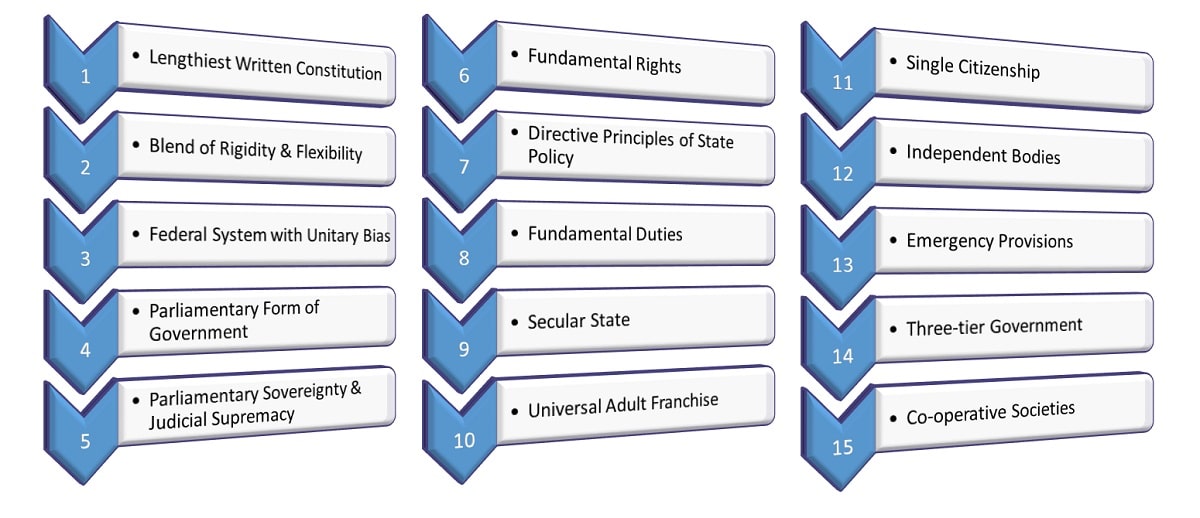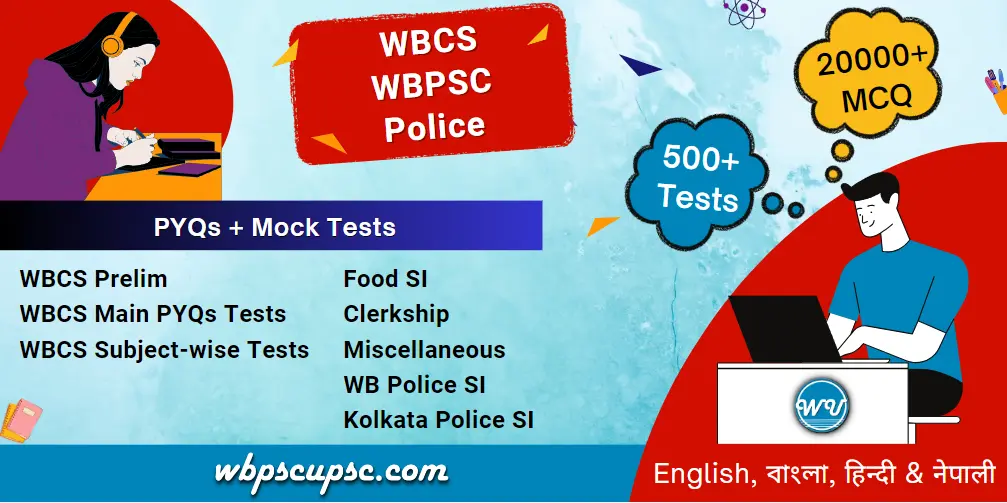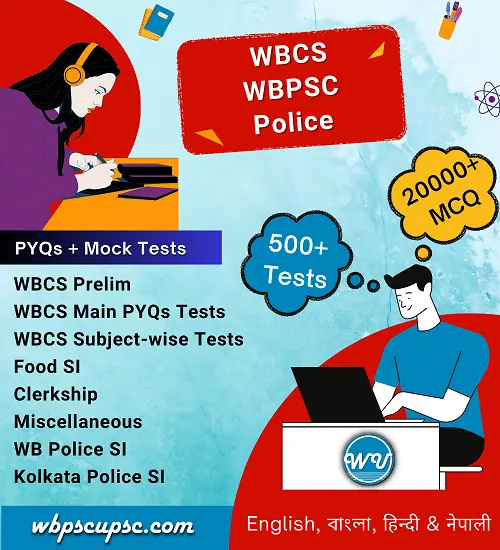March 4, 2020
Salient Features of the Constitution of India
Contents
Salient Features of the Indian Constitution
Lengthiest Written Constitution
- Constitutions are classified into written, like the American Constitution, or unwritten, like the British Constitution.
- The Constitution of India is the lengthiest of all the written constitutions of the world.
- Originally (1949), the Constitution contained a Preamble, 395 Articles divided into 22 Parts and 8 Schedules.
- Various amendments carried out since 1951 have
- Deleted 1 Part (VII)
- Added 4 Parts (IVA, IXA, IXB and XIVA)
- Added 4 Schedules (9, 10, 11 and 12)
Salient Features of the Indian Constitution
Four factors for Lengthiest Constitution
- Geographical factors, that is, the vastness of the country and its diversity.
- Historical influence of the Government of India Act of 1935, which was bulky.
- Single Constitution for both the Centre and the states.
- Dominance of legal luminaries in the Constituent Assembly.
Drawn From Various Sources
- Dr B R Ambedkar proudly acclaimed that the Constitution of India has been framed after ‘ransacking all the known Constitutions of the World

Blend of Rigidity & Flexibility
- Constitutions are also classified into rigid and flexible.
- A rigid Constitution is one that requires a special procedure for its amendment, as for example, the American Constitution.
- A flexible constitution, on the other hand, is one that can be amended in the same manner as the ordinary laws are made, as for example, the British Constitution.
- The Constitution of India is neither rigid nor flexible but a synthesis of both.
Federal System with Unitary Bias
- The Constitution of India establishes a federal system of government.
- Indian Constitution also contains many unitary or non-federal features.
- The term ‘Federation’ has nowhere been used in the Constitution.
- Indian Constitution has been variously described as ‘federal in form but unitary in spirit’
- “Quasi-federal” – K C Wheare,
- “Bargaining federalism” – Morris Jones
- “Co-operative federalism” – Granville Austin
- “Constitution of India is neither purely federal nor purely unitary but is a combination of both” – D. D. Basu
Salient Features of the Indian Constitution
Parliamentary Form of Government
- The Constitution of India has opted for the British parliamentary System of Government rather than American Presidential System of Government.
- The Indian Parliament is not a sovereign body like the British Parliament.
- Further, the Indian State has an elected head (republic) while the British State has hereditary head (monarchy).
- In a parliamentary system the role of the Prime Minister has become so significant and crucial that the political scientists like to call it a ‘Prime Ministerial Government’.
Salient Features of the Indian Constitution
Parliamentary Sovereignty & Judicial Supremacy
- The doctrine of sovereignty of Parliament is associated with the British Parliament
- Principle of judicial supremacy with that of the American Supreme Court.
- The scope of judicial review power of the Supreme Court in India is narrower than that of what exists in US.
- American Constitution provides for ‘due process of law’ against that of ‘procedure established by law’ contained in the Indian Constitution (Article 21).
- The Supreme Court, on the one hand, can declare the parliamentary laws as unconstitutional through its power of judicial review.
Integrated & Independent Judiciary
- The Indian Constitution establishes a judicial system that is integrated as well as independent.
Salient Features of the Indian Constitution
Fundamental Rights
- They operate as limitations on the tyranny of the executive and arbitrary laws of the legislature.
- They are justiciable in nature, that is, they are enforceable by the courts for their violation.
- Fundamental Rights are not absolute and subject to reasonable restrictions.
- Further, they are not sacrosanct and can be curtailed or repealed by the Parliament through a constitutional amendment act.
- They can also be suspended during the operation of a National Emergency except the rights guaranteed by Articles 20 and 21.
Salient Features of the Indian Constitution
Directive Principles of State Policy
- According to Dr B R Ambedkar, the Directive Principles of State Policy is a ‘novel feature’ of the Indian Constitution
- They can be classified into three broad categories- socialistic, Gandhian and liberal–intellectual.
- The directive principles are meant for promoting the ideal of social and economic democracy.
- They seek to establish a ‘welfare state’ in India.
- However, unlike the Fundamental Rights, the directives are non-justiciable in nature
Fundamental Duties
- The original constitution did not provide for the fundamental duties of the citizens.
- These were added during the operation of internal emergency (1975–77) by the 42nd Constitutional Amendment Act of 1976 on the recommendation of the Swaran Singh Committee.
- The 86th Constitutional Amendment Act of 2002 added one more fundamental duty.
A Secular State
- The term ‘secular’ was added to the Preamble of the Indian Constitution by the 42nd Constitutional Amendment Act of 1976.
- The Preamble secures to all citizens of India liberty of belief, faith and worship.
- State shall not deny to any person equality before the law or equal protection of the laws (Article 14).
- State shall not discriminate against any citizen on the ground of religion (Article 15).
- Equality of opportunity for all citizens in matters of public employment (Article 16).
- All persons are equally entitled to freedom of conscience and the right to freely profess, practice and propagate any religion (Article 25).
- Every religious denomination or any of its section shall have the right to manage its religious affairs (Article 26).
- No person shall be compelled to pay any taxes for the promotion of a particular religion (Article 27).
- No religious instruction shall be provided in any educational institution maintained by the State (Article 28).
- Any section of the citizens shall have the right to conserve its distinct language, script or culture (Article 29).
- All minorities shall have the right to establish and administer educational institutions of their choice (Article 30).
- The State shall endeavor to secure for all the citizens a Uniform Civil Code (Article 44).
- Indian Constitution embodies the positive concept of secularism, i.e., giving equal respect to all religions or protecting all religions equally.
Salient Features of the Indian Constitution
Universal Adult Franchise
- The Indian Constitution adopts universal adult franchise as a basis of elections to the Lok Sabha and the state legislative assemblies.
- Every citizen who is not less than 18 years of age has a right to vote without any discrimination of caste, race, religion, sex, literacy, wealth, and so on.
- The voting age was reduced to 18 years from 21 years in 1989 by the 61st Constitutional Amendment Act of 1988.
Single Citizenship
- Though the Indian Constitution is federal and envisages a dual polity it provides for only a single citizenship, that is, the Indian citizenship.
Independent Bodies
- Election Commission to ensure free and fair elections.
- Comptroller and Auditor-General of India to audit the accounts of the Central and state governments.
- Union Public Service Commission
- State Public Service Commission
Emergency Provisions
- National emergency on the ground of war or external aggression or armed rebellion16 (Article 352);
- State emergency (President’s Rule) on the ground of failure of Constitutional machinery in the states (Article 356) or failure to comply with the directions of the Centre (Article 365)
- Financial emergency on the ground of threat to the financial stability or credit of India (Article 360).
- During an emergency, the Central Government becomes all-powerful and the states go into the total control of the centre
Salient Features of the Indian Constitution
Three-tier Government
- 73rd and 74th Constitutional Amendment Acts (1992) have added a third-tier of government which is not found in any other Constitution of the world.
Co-operative Societies
- 97th Constitutional Amendment Act of 2011 gave a constitutional status and protection to co-operative societies.
- It made the right to form co-operative societies a fundamental right (Article 19).
- It included a new Directive Principle of State Policy on promotion of cooperative societies (Article 43-B).
- It added a new Part IX-B in the Constitution which is entitled as “The Cooperative Societies” (Articles 243-ZH to 243-ZT).
Salient Features of the Indian Constitution
Criticism of the Constitution
- A Borrowed Constitution
- A Carbon Copy of the 1935 Act
- Un-Indian or Anti-Indian
- An Un-Gandhian Constitution
- Elephantine Size
- Paradise of the Lawyers
Notes
- About 250 provisions of the 1935 Act have been included in the Constitution.
- 1909, 1919, and 1935 Acts provided for communal representation
- USA gave franchise to women in 1920, Britain in 1928, USSR (now Russia) in 1936, France in 1945, Italy in 1948 and Switzerland in 1971.
- In 1963, IFS was created and it came into existence in 1966.


